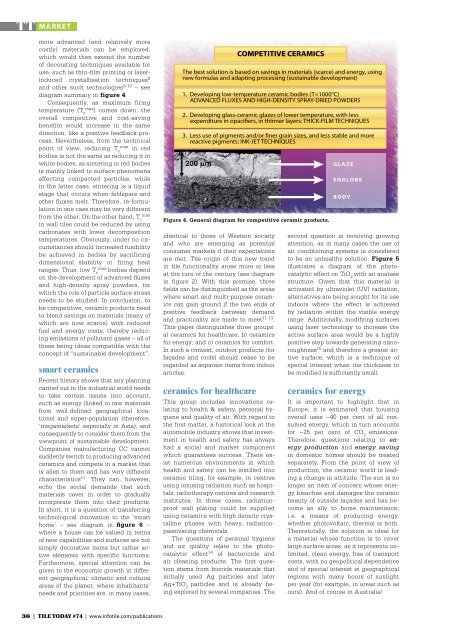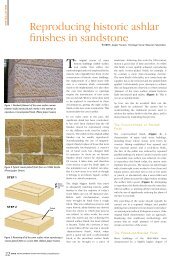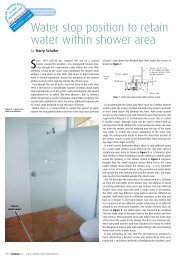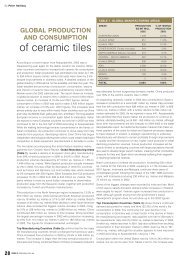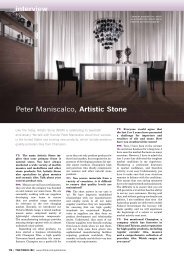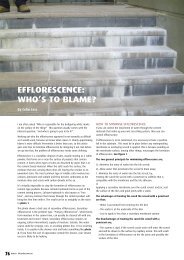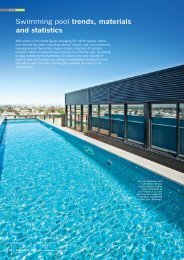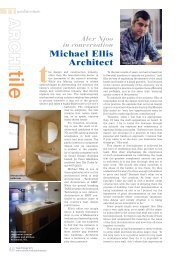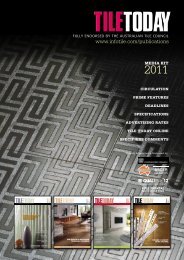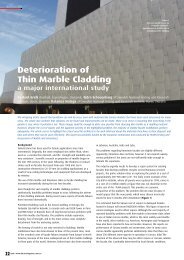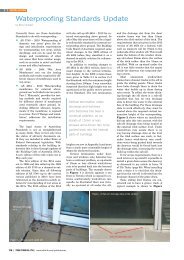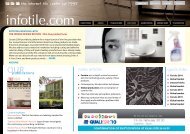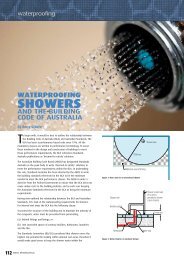Research & Development for Ceramic Tiles in the 21st ... - Infotile
Research & Development for Ceramic Tiles in the 21st ... - Infotile
Research & Development for Ceramic Tiles in the 21st ... - Infotile
You also want an ePaper? Increase the reach of your titles
YUMPU automatically turns print PDFs into web optimized ePapers that Google loves.
TT market<br />
more advanced (and relatively more<br />
costly) materials can be employed,<br />
which would <strong>the</strong>n extend <strong>the</strong> number<br />
of decorat<strong>in</strong>g techniques available <strong>for</strong><br />
use, such as th<strong>in</strong>-film pr<strong>in</strong>t<strong>in</strong>g or laser<strong>in</strong>duced<br />
crystallisation techniques 8<br />
and o<strong>the</strong>r such technologies 9-10 – see<br />
diagram summary <strong>in</strong> figure 4.<br />
Consequently, as maximum fir<strong>in</strong>g<br />
temperature (T c max ) comes down, <strong>the</strong><br />
overall competitive and cost-sav<strong>in</strong>g<br />
benefits would <strong>in</strong>crease <strong>in</strong> <strong>the</strong> same<br />
direction, like a positive feedback process.<br />
Never<strong>the</strong>less, from <strong>the</strong> technical<br />
po<strong>in</strong>t of view, reduc<strong>in</strong>g T c<br />
max<br />
<strong>in</strong> red<br />
bodies is not <strong>the</strong> same as reduc<strong>in</strong>g it <strong>in</strong><br />
white bodies, as s<strong>in</strong>ter<strong>in</strong>g <strong>in</strong> red bodies<br />
is ma<strong>in</strong>ly l<strong>in</strong>ked to surface phenomena<br />
affect<strong>in</strong>g compacted particles, while<br />
<strong>in</strong> <strong>the</strong> latter case, s<strong>in</strong>ter<strong>in</strong>g is a liquid<br />
stage that occurs when feldspars and<br />
o<strong>the</strong>r fluxes melt. There<strong>for</strong>e, re-<strong>for</strong>mulation<br />
<strong>in</strong> one case may be very different<br />
from <strong>the</strong> o<strong>the</strong>r. On <strong>the</strong> o<strong>the</strong>r hand, T c<br />
max<br />
<strong>in</strong> wall tiles could be reduced by us<strong>in</strong>g<br />
carbonates with lower decomposition<br />
temperatures. Obviously, under no circumstances<br />
should <strong>in</strong>creased fusibility<br />
be achieved <strong>in</strong> bodies by sacrific<strong>in</strong>g<br />
dimensional stability or fir<strong>in</strong>g heat<br />
ranges. Thus, low T c<br />
max<br />
bodies depend<br />
on <strong>the</strong> development of advanced fluxes<br />
and high-density spray powders, <strong>for</strong><br />
which <strong>the</strong> role of particle surface stress<br />
needs to be studied. In conclusion, to<br />
be competitive, ceramic products need<br />
to blend sav<strong>in</strong>gs on materials (many of<br />
which are now scarce) with reduced<br />
fuel and energy costs, <strong>the</strong>reby reduc<strong>in</strong>g<br />
emissions of pollutant gases – all of<br />
<strong>the</strong>se be<strong>in</strong>g ideas compatible with <strong>the</strong><br />
concept of “susta<strong>in</strong>able development”.<br />
smart ceramics<br />
Recent history shows that any plann<strong>in</strong>g<br />
carried out <strong>in</strong> <strong>the</strong> <strong>in</strong>dustrial world needs<br />
to take certa<strong>in</strong> issues <strong>in</strong>to account,<br />
such as energy (l<strong>in</strong>ked to raw materials<br />
from well-def<strong>in</strong>ed geographical locations)<br />
and super-population (<strong>the</strong>re<strong>for</strong>e,<br />
‘mega markets’ especially <strong>in</strong> Asia), and<br />
consequently to consider <strong>the</strong>m from <strong>the</strong><br />
viewpo<strong>in</strong>t of susta<strong>in</strong>able development.<br />
Companies manufactur<strong>in</strong>g CC cannot<br />
suddenly switch to produc<strong>in</strong>g advanced<br />
ceramics and compete <strong>in</strong> a market that<br />
is alien to <strong>the</strong>m and has very different<br />
characteristics 11 . They can, however,<br />
echo <strong>the</strong> social demands that such<br />
materials cover <strong>in</strong> order to gradually<br />
<strong>in</strong>corporate <strong>the</strong>m <strong>in</strong>to <strong>the</strong>ir products.<br />
In short, it is a question of transferr<strong>in</strong>g<br />
technological <strong>in</strong>novation to <strong>the</strong> ‘smart<br />
home’ – see diagram <strong>in</strong> figure 6 –<br />
where a house can be valued <strong>in</strong> terms<br />
of new capabilities and surfaces are not<br />
simply decorative items but ra<strong>the</strong>r active<br />
elements with specific functions.<br />
Fur<strong>the</strong>rmore, special attention can be<br />
given to <strong>the</strong> economic growth <strong>in</strong> different<br />
geographical, climatic and cultural<br />
areas of <strong>the</strong> planet, where <strong>in</strong>habitants’<br />
needs and priorities are, <strong>in</strong> many cases,<br />
identical to those of Western society<br />
and who are emerg<strong>in</strong>g as potential<br />
consumer markets if <strong>the</strong>ir expectations<br />
are met. The orig<strong>in</strong> of this new trend<br />
<strong>in</strong> tile functionality arose more or less<br />
at <strong>the</strong> turn of <strong>the</strong> century (see diagram<br />
<strong>in</strong> figure 2). With this premise, three<br />
fields can be dist<strong>in</strong>guished as <strong>the</strong> areas<br />
where smart and multi-purpose ceramics<br />
can ga<strong>in</strong> ground if <strong>the</strong> two ends of<br />
positive feedback between demand<br />
and practicality are made to meet 11-13 .<br />
This paper dist<strong>in</strong>guishes three groups:<br />
a) ceramics <strong>for</strong> healthcare; b) ceramics<br />
<strong>for</strong> energy; and c) ceramics <strong>for</strong> com<strong>for</strong>t.<br />
In such a context, outdoor products (<strong>for</strong><br />
façades and roofs) should cease to be<br />
regarded as separate items from <strong>in</strong>door<br />
articles.<br />
ceramics <strong>for</strong> healthcare<br />
This group <strong>in</strong>cludes <strong>in</strong>novations relat<strong>in</strong>g<br />
to health & safety, personal hygiene<br />
and quality of air. With regard to<br />
<strong>the</strong> first matter, a historical look at <strong>the</strong><br />
automobile <strong>in</strong>dustry shows that <strong>in</strong>vestment<br />
<strong>in</strong> health and safety has always<br />
had a social and market component<br />
which guarantees success. There exist<br />
numerous environments <strong>in</strong> which<br />
health and safety can be <strong>in</strong>stilled <strong>in</strong>to<br />
ceramic til<strong>in</strong>g, <strong>for</strong> example, <strong>in</strong> centres<br />
us<strong>in</strong>g ionis<strong>in</strong>g radiation such as hospitals,<br />
radio<strong>the</strong>rapy centres and research<br />
<strong>in</strong>stitutes. In <strong>the</strong>se cases, radiationproof<br />
wall plat<strong>in</strong>g could be supplied<br />
us<strong>in</strong>g ceramics with high density crystall<strong>in</strong>e<br />
phases with heavy, radiationpassivat<strong>in</strong>g<br />
chemicals.<br />
The questions of personal hygiene<br />
and air quality relate to <strong>the</strong> photocatalytic<br />
effect 14 of bactericide and<br />
air clean<strong>in</strong>g products. The first question<br />
stems from biocide materials that<br />
<strong>in</strong>itially used Ag particles and later<br />
Ag+TiO 2<br />
particles and is already be<strong>in</strong>g<br />
explored by several companies. The<br />
COMPETITIVE CERAMICS<br />
The best solution is based on sav<strong>in</strong>gs <strong>in</strong> materials (scarce) and energy, us<strong>in</strong>g<br />
new <strong>for</strong>mulas and adapt<strong>in</strong>g process<strong>in</strong>g (susta<strong>in</strong>able development)<br />
1. Develop<strong>in</strong>g low-temperature ceramic bodies (T


